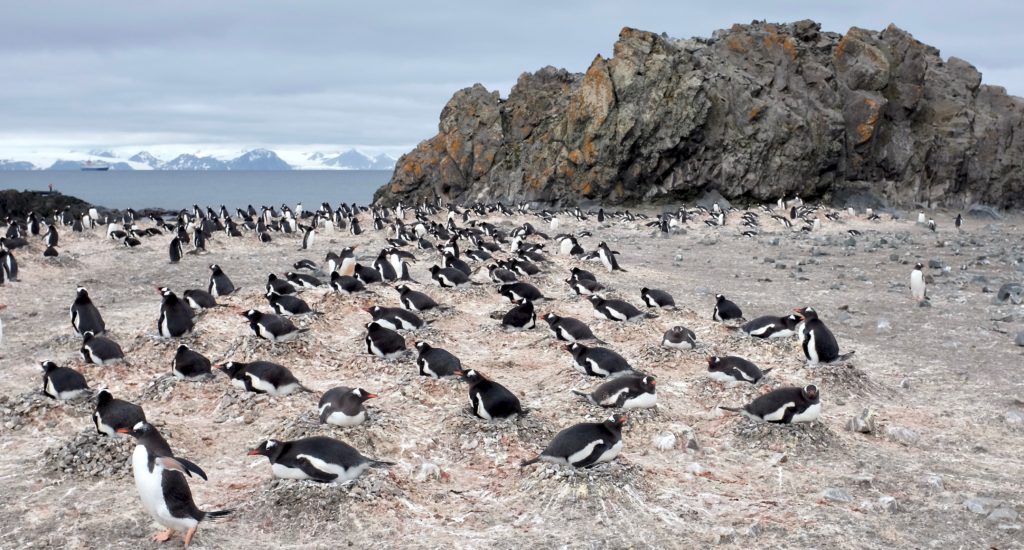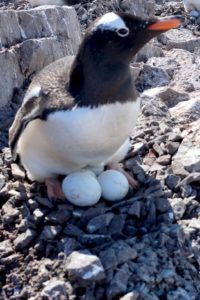Written by Ron Naveen, President of Oceanites

With continued support from the UK Foreign & Commonwealth Office and the Government of the British Antarctic Territory, the nonprofit science and education organisation, Oceanites, has completed the 26th consecutive field season of its unparalleled Antarctic Site Inventory (ASI) project.
Antarctic Site Inventory (ASI)
The ASI began in 1994 and was designed to assist the implementation of the 1991 Protocol on Environmental Protection to the Antarctic Treaty. The Protocol requires a preliminary environmental impact assessment for all activities, including tourism, to be conducted and for monitoring to be done, as and when necessary, to assess and verify predicted environmental impacts.
Uniquely, the ASI has been continuously monitoring penguin and seabird population changes since its inception. This has proved quite critical because, over six decades, the Antarctic Peninsula has experienced a year-round temperature increase of 3˚C / 5˚F and an even greater increase in winter by 5˚C / 9˚F. ASI data and analyses have been essential to understanding the disparate penguin population responses during this warming period — the gentoo penguin population has been increasing significantly and its breeding locations expanding southward, while the Adélie and chinstrap penguins populations have decreased significantly.

The ASI now has amassed 2,100 census visits and collected data at 258 different Antarctic Peninsula locations. During the recently concluded 2019-20 field season, the ASI made 53 census visits and collected data at 43 different sites, all data collected this season from tour ships (Poseidon Expeditions’ ship Sea Spirit, and the Hurtigruten ship Fram). The ASI focuses on obtaining penguin nest counts at the peak of egg-laying (approximately early December to early January) and penguin chick counts at the peak of penguin chick-crèching (approximately early January to early February).

The project has demonstrated an ability to reach Antarctic Peninsula visitor sites frequently and cost-effectively, relying opportunistically for logistics support on expedition tour vessels, yachts, and, occasionally, government vessels — including most notably, in the late 1990s, the Royal Navy’s ice patrol ship HMS Endurance. These visits by trained researchers have proved an effective means of characterizing sites and for the collecting relevant biological data. (The ASI’s history and research plan is more fully delineated on its website).
The long-standing cooperation between Oceanites and FCO/BAT has generated significant achievements within the Antarctic Treaty System. For example:
- 1997: publication of the first edition of Oceanites’ Compendium of Antarctic Peninsula Visitor Sites
- 2006: Oceanites was tasked by the FCO to draft the initial set of ten site-specific visitor guidelines, which the UK ultimately proposed for adoption by the Antarctic Treaty Consultative Parties. These drafts were based on penguin/seabird population data and site-descriptive information compiled by the ASI. It took three consultative meetings for this initial group of guidelines to be adopted and there are now guidelines for more than 50 sites (see complete list on the Antarctic Treaty Secretariat website).
The FCO’s and BAT’s ongoing support of the ASI ensures that data are made freely and publicly available so that all Antarctic Treaty stakeholders can access the best scientific information to distinguish the direct and interactive effects of climate change, fishing, tourism, and national operations on ecosystems in the Antarctic Peninsula for improved environmental management.
Mapping Application for Penguin Populations and Projected Dynamics (MAPPPD)
One aspect of this is Oceanites maintaining the Mapping Application for Penguin Populations and Projected Dynamics (MAPPPD) database, which is an open access decision support tool that provides a ‘one-stop’ shop for information on penguin abundance and distribution of all five Antarctic penguin species (http://www.penguinmap.com). ASI data flows into MAPPPD, which integrates citizen science, expert biological field surveys, and satellite imagery to provide data required for Antarctic decision support and conservation assessment. MAPPPD now includes 3,736 records from 116 sources of on-the-ground colony counts and satellite photo analyses.
Oceanites relies on the MAPPPD database to generate its annual State of Antarctic Penguins reports. The most recent report of 2019 notes that the five Antarctic penguin species total at least 6.186 million breeding pairs nesting at 662 or more sites across the entire Antarctic continent. A new report is slated for release in late 2020.
Find out More
- Oceanites.org
- Children’s e-Book – Ron Counts Penguins
- State of Antarctic Penguins, 2019
